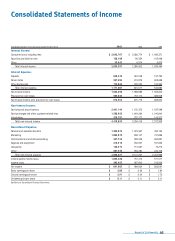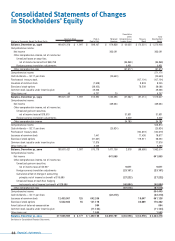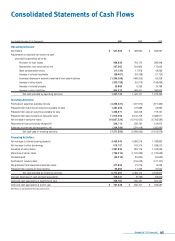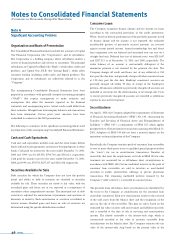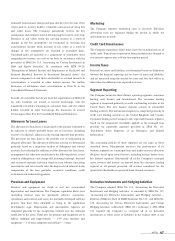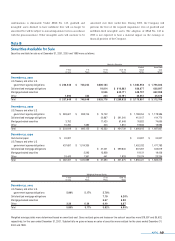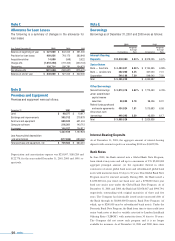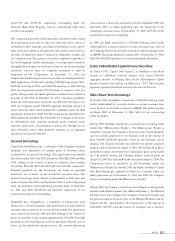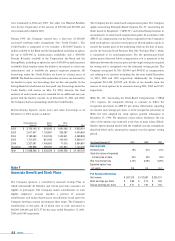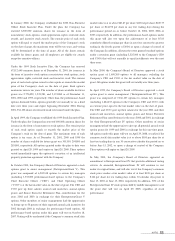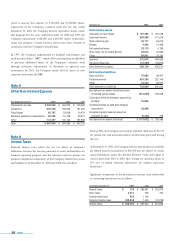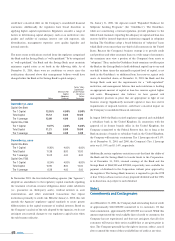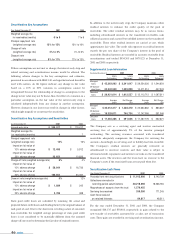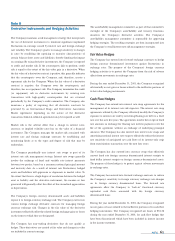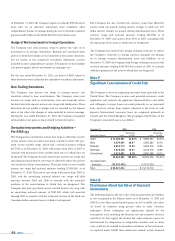Capital One 2001 Annual Report Download - page 54
Download and view the complete annual report
Please find page 54 of the 2001 Capital One annual report below. You can navigate through the pages in the report by either clicking on the pages listed below, or by using the keyword search tool below to find specific information within the annual report.
were terminated in February 2001. The other two Bilateral Facilities
were for the Corporation in the amount of $70,000 and $30,000 and
were terminated in March 2001.
During 1999, the Company entered into a four-year, $1,200,000
unsecured revolving credit arrangement (the “Credit Facility”). The
Credit Facility is comprised of two tranches: a $810,000 Tranche A
facility available to the Bank and the Savings Bank, including an option
for up to $250,000 in multicurrency availability; and a $390,000
Tr anche B facility available to the Corporation, the Bank and the
Savings Bank, including an option for up to $150,000 in multicurrency
availability. Each tranche under the facility is structured as a four-year
commitment and is available for general corporate purposes. All
borrowings under the Credit Facility are based on varying terms of
LIBOR. The Bank has irrevocably undertaken to honor any demand by
the lenders to repay any borrowings that are due and payable by the
Savings Bank but which have not been paid. Any borrowings under the
Credit Facility will mature on May 24, 2003; however, the final
maturity of each tranche may be extended for an additional one-year
period with the lenders’ consent. As of December 31, 2001 and 2000,
the Company had no outstandings under the Credit Facility.
Interest-bearing deposits, senior notes and other borrowings as of
December 31, 2001, mature as follows:
Note F
Associate Benefit and Stock Plans
The Company sponsors a contributory Associate Savings Plan in
which substantially all full-time and certain part-time associates are
eligible to participate. The Company makes contributions to each
eligible employee's account, matches a portion of associate
contributions and makes discretionary contributions based upon the
Company meeting a certain earnings per share target. The Company's
contributions to this plan, all of which were in cash, amounted to
$64,299, $44,486 and $27,157 for the years ended December 31, 2001,
2000 and 1999, respectively.
The Company has five stock-based compensation plans. The Company
applies Accounting Principles Board Opinion No. 25, “Accounting for
Stock Issued to Employees” (“APB 25”) and related Interpretations in
accounting for its stock-based compensation plans. In accordance with
APB 25, no compensation cost has been recognized for the Company's
fixed stock options, since the exercise price of all such options equals or
exceeds the market price of the underlying stock on the date of grant,
nor for the Associate Stock Purchase Plan (the “Purchase Plan”), which
is considered to be noncompensatory. For the performance-based
option grants discussed below, compensation cost is measured as the
difference between the exercise price and the target stock price required
for vesting and is recognized over the estimated vesting period. The
Company recognized $1,768, $10,994 and $44,542 of compensation
cost relating to its associate stock plans for the years ended December
31, 2001, 2000 and 1999, respectively. Additionally, the Company
recognized $113,498, $47,025 and $1,046 of tax benefits from the
exercise of stock options by its associates during 2001, 2000 and 1999,
respectively.
SFAS No. 123, “Accounting for Stock-Based Compensation” (“SFAS
123”) requires, for companies electing to continue to follow the
recognition provisions of APB 25, pro forma information regarding
net income and earnings per share, as if the recognition provisions of
SFAS 123 were adopted for stock options granted subsequent to
December 31, 1994. For purposes of pro forma disclosure, the fair
value of the options was estimated at the date of grant using a Black-
Scholes option-pricing model with the weighted average assumptions
described below and is amortized to expense over the options' vesting
period.
52 notes
Interest-Bearing Senior Other
Deposits Notes Borrowings Total
2002 $ 3,723,143 $ 518,635 $ 1,691,436 $ 5,933,214
2003 2,611,507 1,105,861 326,287 4,043,655
2004 2,182,684 1,042,184 1,043,941 4,268,809
2005 1,701,675 812,462 415,000 2,929,137
2006 2,327,061 1,456,800 71,000 3,854,861
Thereafter 292,898 399,287 447,864 1,140,049
Total $ 12,838,968 $ 5,335,229 $ 3,995,528 $ 22,169,725
Year Ended December 31 2001 2000 1999
Assumptions
Dividend yield .19% .21% .24%
Volatility factors of expected
market price of stock 50% 49% 45%
Risk-free interest rate 4.15% 6.09% 5.29%
Expected option lives
(in years) 8.5 4.5 5.4
Pro Forma Information
Net income $ 597,313 $ 412,987 $ 325,701
Basic earnings per share $ 2.85 $ 2.10 $ 1.65
Diluted earnings per share $ 2.71 $ 1.97 $ 1.55



